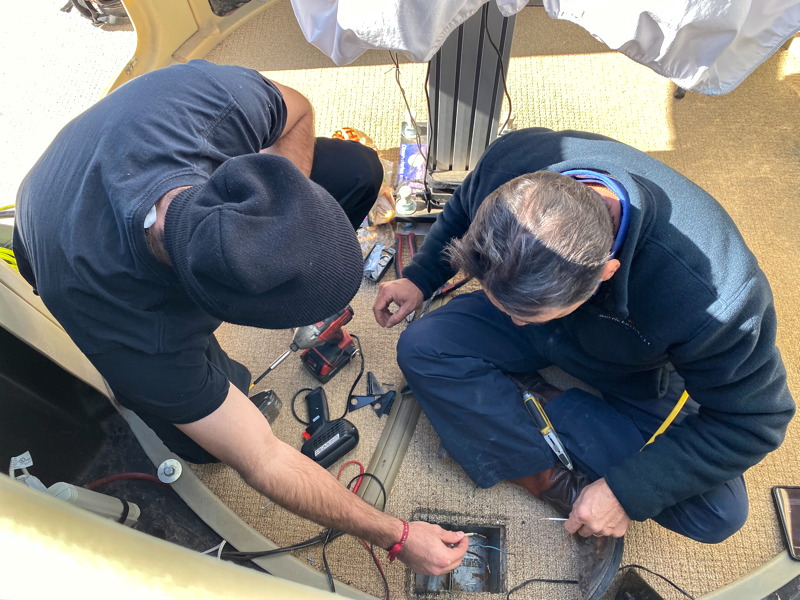Observatory Power Update;
Bahtinov Mask tests, iPhone Messier imaging
Posted: 20 December 2019
Tuesday, 17 December 2019, dawned clear, windy, and cold (low of 28°F). Overnight a bird bath had developed an "ice spike".

This was the second ice spike I've seen. The first was a year ago on 29 December 2018, as seen below.

Wednesday, 18 December, the winds continued and cloudy skies returned.
Due to the ongoing power outage in the observatory, I ordered a Masterplug 80ft Open Cord Reel and an Epicord 16/3 Outdoor Extension Cord (100 ft) to use as a backup electrical source for the observatory. I placed the cords from the observatory up the pathway to the house. As luck would have it they did not arrive until Wednesday and of course it was cloudy that night. But now the observatory has temporary power available!


Thursday, 19 December, dawned mostly cloudy but the sky cleared by mid-morning. And the electrician came to install the replacement outlets in the observatory. He brought along his son who is very interested in astronomy. During the day we chatted about lots of astronomy and telescope related topics. During the installation a wasp came to supervise.



Nice to have normal power again at Cassiopeia Observatory! And water getting onto the outlets will no longer be concern.
|
Open: Thursday, 19 December 2019, 1806 MST Temperature: 57°F |
Session: 1416 Conditions: Clear |
Equipment:
12" f/8 LX600 w/StarLock
2" 24mm UWA eyepiece
2" 30mm eyepiece
Camera:
D850 DSLR
iPhone 11 Pro Max
1812 MST: LX600 ON, StarLock OFF, High Precision OFF.
Viewed Saturn, low and through a tree, 102X. Then viewed Venus, 102X. Venus showed a bright gibbous phase. I also made some slight adjustments to the alignments of the two finderscopes.
1820-1836 MST: observed three SpaceX Starlink satellites from the second batch that was launched a few weeks ago. One flared brightly (about Mag. 0) and the other two were faint (about Mag. +5). I would have probably seen many more but I wanted to do other stuff in the observatory that had been delayed by the long power outage (since 21 November).
1843 MST: began preparing to do some D850 DSLR prime focus imaging to test my new Meade Bahtinov Mask. 1918 MST: tests completed. I will post a review soon.
Next, I began setting up to image some Messier objects for my iPhone Messier Catalog astrophotography album. Viewed M35 (open star cluster), 102X and 81X. I then mounted the iPhone 11 Pro Max on the 2" 30mm eyepiece using the Levenhuk Smartphone Adapter. I used the Earbuds as a remote shutter release with the iOS app NightCap Camera (Light Boost, ISO 12500, 1sec, 1X lens) for the following afocal 81X images of open star clusters.
M35

M36

M37

M38

1940 MST: I then saw that clouds were rapidly coming in. I decided to skip my planned D850 DSLR imaging of an asteroid as the clouds would soon cover the sky. Since M1 (Crab Nebula) was still visible I imaged it.
1941 MST: StarLock ON.
Took this iPhone image of M1, StarLock autoguided, afocal 81X, NightCap Camera (Long Exposure, Light Boost, ISO 12288, 1sec, 1 minute exposure, 1X lens).
M1 (Crab Nebula)

1946 MST: StarLock OFF.
Viewed M1, 81X and 102X. Good view.
1952 MST: LX600 OFF.
It was great to be back in the observatory at the 12" telescope!
|
Close: Thursday, 19 December 2019, 2006 MST Temperature: 42°F |
Session Length: 2h 00m Conditions: Mostly cloudy |
Comments are welcome using Email. Twitter users can use the button below to tweet this report to their followers. Thanks.
Cassiopeia Observatory Home Page
Copyright ©2019 Michael L. Weasner / mweasner@me.com
URL = http://www.weasner.com/co/Reports/2019/12/20/index.html
